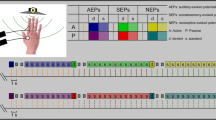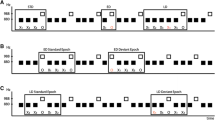Abstract
Mismatch negativity (MMN) represents an event-related potential (ERP) component which is elicited by deviant sound events in an otherwise regular, repetitive stimulation. The MMN amplitude typically decreases when two identical deviants are presented in direct succession, but it remains stable when the two deviants vary from the standard in different features. Less is known about such repetition effects on another ERP component, the P3a, which usually follows the MMN. In the current study, we investigated how the P3a was affected by identical and non-identical repetitions of sound deviants. The ERP analysis revealed that the P3a amplitudes were strongly diminished when the repeated deviants were identical, but the P3a remained stable when the repeated deviants varied. The findings suggest that not only the deviance detection system, as reflected in the MMN, but also subsequent attention switch systems, as reflected in the P3a, operate independently across different sound features.



Similar content being viewed by others
References
Bekinschtein TA, Dehaene S, Rohaut B, Tadel F, Cohen L, Naccache L (2009) Neural signature of the conscious processing of auditory regularities. Proc Natl Acad Sci 106(5):1672–1677
Comerchero MD, Polich J (1999) P3a and P3b from typical auditory and visual stimuli. Clin Neurophysiol 110:24–30
Deacon D, Gomes H, Nousak JM, Ritter W, Javitt D (2000) Effect of frequency separation and stimulus rate on the mismatch negativity: an examination of the issue of refractoriness in humans. Neurosci Lett 287:167–170
Escera C, Alho K, Schröger E, Winkler I (2000) Involuntary attention and distractibility as evaluated with event-related brain potentials. Audiol Neurootol 5(3–4):151–166
Friedman D, Cycowicz Y, Gaeta H (2001) The novelty P3: an event-related brain potential (ERP) sign of the brain’s evaluation of novelty. Neurosci Biobehav Rev 25(4):355–373
Friedman D, Nessler D, Kulik J, Hamberger M (2011) The brain’s orienting response (novelty P3) in patients with unilateral temporal lobe resections. Neuropsychologia 49(12):3474–3483
Friston K (2005) A theory of cortical responses. Philos Trans R Soc Lond B Biol Sci 360(1456):815–836
Friston K, Kiebel S (2009) Predictive coding under the free-energy principle. Philos Trans R Soc Lond B Biol Sci 364(1521):1211–1221
Garrido MI, Kilner JM, Kiebel SJ, Stephan KE, Friston KJ (2007) Dynamic causal modelling of evoked potentials: a reproducibility study. Neuroimage 36(3):571–580
Grimm S, Escera C, Nelken I (2016) Early indices of deviance detection in humans and animal models. Biol Psychol 116:23–27
Hagen GF, Gatherwright JR, Lopez BA, Polich J (2006) P3a from visual stimuli: task difficulty effects. Int J Psychophysiol 59(1):8–14
Horváth J, Bendixen A (2012) Preventing distraction by probabilistic cueing. Int J Psychophysiol 83(3):342–347
Horváth J, Winkler I, Bendixen A (2008) Do N1/MMN, P3a, and RON form a strongly coupled chain reflecting the three stages of auditory distraction? Biol Psychol 79(2):139–147
Hsiao FJ, Wu ZA, Ho LT, Lin YY (2009) Theta oscillation during auditory change detection: an MEG study. Biol Psychol 81(1):58–66
Jacobsen T, Schröger E (2001) Is there a pre-attentive memory-based comparison of pitch? Psychophysiology 38:723–727
Jacobsen T, Schröger E (2003) Measuring duration mismatch negativity. Clin Neurophysiol 114(6):1133–1143
Jacobsen TK, Steinberg J, Truckenbrodt H, Jacobsen T (2013) Mismatch Negativity (MMN) to successive deviants within one hierarchically structured auditory object. Int J Psychophysiol 87(1):1–7
Javitt DC, Lee M, Kantrowitz JT, Martinez A (2018) Mismatch negativity as a biomarker of theta band oscillatory dysfunction in schizophrenia. Schizophr Res 191:51–60
Lecaignard F, Bertrand O, Gimenez G, Mattout J, Caclin A (2015) Implicit learning of predictable sound sequences modulates human brain responses at different levels of the auditory hierarchy. Front Hum Neurosci 9:505
Müller D, Schröger E (2007) Temporal grouping affects the automatic processing of deviant sounds. Biol Psychol 74(3):358–364
Müller D, Widmann A, Schröger E (2005a) Deviance-repetition effects as a function of stimulus feature, feature value variation, and timing: a mismatch negativity study. Biol Psychol 68:1–14
Müller D, Widmann A, Schröger E (2005b) Auditory streaming affects the processing of successive deviant and standard sounds. Psychophysiology 42(6):668–676
Näätänen R (1990) The role of attention in auditory by event-related potentials and other brain measures of cognitive function. Behav Brain Sci 13:201–288
Näätänen R, Alho K (1995) Mismatch negativity–a unique measure of sensory processing in audition. Int J Neurosci 80(1–4):317–337
Näätänen R, Gaillard AW, Mäntysalo S (1978) Early selective-attention effect on evoked potential reinterpreted. Acta Psychol (Amst) 42(4):313–329
Näätänen R, Pakarinen S, Rinne T, Takegata R (2004) The mismatch negativity (MMN): Towards the optimal paradigm. Clin Neurophysiol 115(1):140–144
Nicol RM, Chapman SC, Vertes PE, Nathan PJ, Smith ML, Shtyrov Y et al (2012) Fast reconfiguration of high-frequency brain networks in response to surprising changes in auditory input. J Neurophysiol 107(5):1421–1430
Nousak JM, Deacon D, Ritter W, Vaughan HG (1996) Storage of information in transient auditory memory. Brain Res Cogn Brain Res 4(4):305–317
Pakarinen S, Lovio R, Huotilainen M, Alku P, Näätänen R, Kujala T (2009) Fast multi-feature paradigm for recording several mismatch negativities (MMNs) to phonetic and acoustic changes in speech sounds. Biol Psychol 82(3):219–226
Pakarinen S, Huotilainen M, Näätänen R (2010) The mismatch negativity (MMN) with no standard stimulus. Clin Neurophysiol 121(7):1043–1050
Partanen E, Torppa R, Pykäläinen J, Kujala T, Huotilainen M (2013) Children’s brain responses to sound changes in pseudo words in a multifeature paradigm. Clin Neurophysiol 124(6):1132–1138
Rinne T, Särkkä A, Degerman A, Schröger E, Alho K (2006) Two separate mechanisms underlie auditory change detection and involuntary control of attention. Brain Res 1077(1):135–143
Sams M, Alho K, Näätänen R (1984) Short-term habituation and dishabituation of the mismatch negativity of the ERP. Psychophysiology 21(4):434–441
Sawaki R, Katayama J (2006) Stimulus context determines whether non-target stimuli are processed as task-relevant or distractor information. Clin Neurophysiol 117(11):2532–2539
Schröger E (1997) On the detection of auditory deviations: a pre-attentive activation model. Psychophysiology 34(3):245–257
Schubert M, Johannes S, Koch M, Wieringa BM, Dengler R, Munte TF (1998) Differential effects of two motor tasks on ERPs in an auditory classification task: evidence of shared cognitive resources. Neurosci Res 30(2):125–134
Sorokin A, Alku P, Kujala T (2010) Change and novelty detection in speech and non-speech sound streams. Brain Res 1327:77–90
Strauss M, Sitt JD, King J-R, Elbaz M, Azizi L, Buiatti M et al (2015) Disruption of hierarchical predictive coding during sleep. Proc Natl Acad Sci 112(11):E1353–E1362
Sussman E, Winkler I, Ritter W, Alho K, Näätänen N (1999) Temporal integration of auditory stimulus deviance as reflected by the mismatch negativity. Neurosci Lett 264(1–3):161–164
Sussman E, Winkler I, Schröger E (2003) Top-down control over involuntary attention switching in the auditory modality. Psychon Bull Rev 10(3):630–637
Tavakoli P, Campbell K (2016) Can an auditory multi-feature optimal paradigm be used for the study of processes associated with attention capture in passive listeners? Brain Res 1648:394–408
Todd J, Mullens D (2011) Implementing conditional inference in the auditory system: what matters?. Psychophysiology 48(10):1434–1443
Todd J, Robinson J (2010) The use of conditional inference to reduce prediction error? A mismatch negativity (MMN) study. Neuropsychologia 48(10):3009–3018
Todd J, Myers R, Pirillo R, Drysdale K (2010) Neuropsychological correlates of auditory perceptual inference: a mismatch negativity (MMN) study. Brain Res 1310:113–123
Todd J, Whitson L, Smith E, Michie PT, Schall U, Ward PB (2014) What’s intact and what’s not within the mismatch negativity system in schizophrenia. Psychophysiology 51(4):337–347
Volosin M, Horváth J (2014) Knowledge of sequence structure prevents auditory distraction: an ERP study. Int J Psychophysiol 92(3):93–98
Wacongne C, Labyt E, van Wassenhove V, Bekinschtein T, Naccache L, Dehaene S (2011) Evidence for a hierarchy of predictions and prediction errors in human cortex. Proc Natl Acad Sci 108(51):20754–20759
Winkler I (2007) Interpreting the mismatch negativity. J Psychophysiol 21(3):147–163
Winkler I, Czigler I, Jaramillo M, Paavilainen P, Näätänen R (1998) Temporal constraints of auditory event synthesis: evidence from ERPs. Neuroreport 9(3):495–499
Acknowledgements
The authors greatly appreciate the assistance of Melanie Hilz and Jacqueline Hamann in collecting part of the data. We greatly appreciated the constructive feedback of the three anonymous reviewers.
Author information
Authors and Affiliations
Corresponding author
Ethics declarations
Conflict of interest
None of the authors have potential conflicts of interest to be disclosed.
Electronic supplementary material
Below is the link to the electronic supplementary material.
Rights and permissions
About this article
Cite this article
Rosburg, T., Weigl, M., Thiel, R. et al. The event-related potential component P3a is diminished by identical deviance repetition, but not by non-identical repetitions. Exp Brain Res 236, 1519–1530 (2018). https://doi.org/10.1007/s00221-018-5237-z
Received:
Accepted:
Published:
Issue Date:
DOI: https://doi.org/10.1007/s00221-018-5237-z




